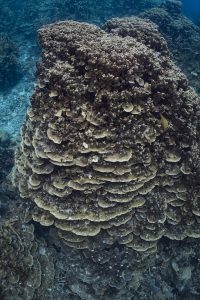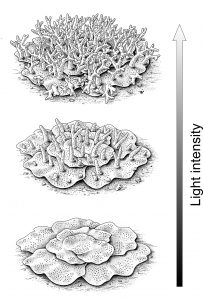Group of scientists from the University of Warsaw, the Adam Mickiewicz University in Poznań and the California Academy of Sciences studied fossils of tabulate corals from the Middle Devonian (ca. 385 million years ago). The scientists’ observations suggest that these organisms shared remarkably similar adaptations to changing light conditions with modern corals.
Life has an impressive potential to adjust to environmental conditions. A phenomenon related to that fact is so-called phenotypic plasticity, which manifests itself in the ability of a given organism to develop different characteristics, such as morphology, physiology or behaviour, depending on the environmental factors affecting it, as part of its ‘genetic programme’. This phenomenon is particularly well visible in corals.
“A large part of modern corals live in symbiosis with photosynthesising algae (dinoflagellates), so the availability of light is crucial to their functioning. Depending on the amount of available light, corals adjust the shape of their colonies to extract energy from it as efficiently as possible. A vivid example of this phenomenon is displayed by representatives of the genus Porities, which develop platy colonies in low-light conditions, while when light is abundant their colonies have a branching shape. Interestingly, intermediate forms with a flat colony base and branches growing out of it may also appear. However, this phenomenon has remained unknown in the fossil reefs,” Prof. Zapalski from the UW Faculty of Geology says.
The scientists examined material from modern Morocco, Belgium and Poland, which consisted of Devonian corals from the now extinct Tabulata group, living during the time of a great development of reef ecosystems, under varying light conditions. The observations showed that, depending on the amount of light available, representatives of the genus Roseoporella developed colony shapes that was almost identical with those of modern Porites corals.
“The study shows that, despite almost 400 million years separating Devonian and modern corals, these organisms showed surprisingly similar responses to changing environmental conditions. This provides a unique opportunity for further comparative research,” explains Prof. Mikołaj Zapalski.
An article presenting the research results appeared in the journal “Coral Reefs”. It was created in cooperation with scientists from the Faculty of Geology of the University of Warsaw (doctoral candidate Aleksander Majchrzyk and Prof. Mikołaj Zapalski), Prof. Michał Jakubowicz (Adam Mickiewicz University in Poznań) and Dr. Pim Bongaerts of the California Academy of Sciences.
Majchrzyk, A., Jakubowicz, M., Bongaerts, P. & Zapalski M. K. Different times, similar mechanism? Convergent patterns in light-induced phenotypic plasticity in Devonian and modern corals. Coral Reefs (2023). https://doi.org/10.1007/s00338-023-02394-4





